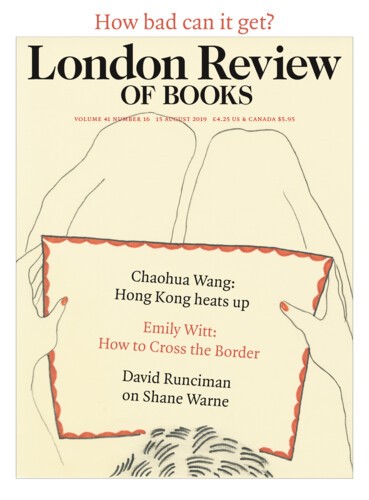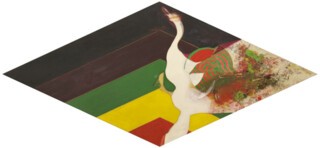‘My art is formalist,’ Frank Bowling wrote in 1988, ‘and my experience is that of a black artist.’ What might appear an opposition between formalist concerns and lived experience has proved, for Bowling, a powerful dualism. His current retrospective at Tate Britain (until 26 August) is his first at a British gallery. Institutional recognition has been slow, despite presentations at the Whitney in 1971 and the Serpentine in 1986. Bowling was made a Royal Academician in 2005 but he has remained a quiet man of British art in comparison with David Hockney or R.B. Kitaj, his contemporaries at the Royal College of Art in the early 1960s.
The exhibition shows how decisively he transcends the well-worn term ‘postwar British artist’: Bowling is diasporic, resisting easy definition. Born in 1934 in Bartica, Guyana, he grew up in New Amsterdam and moved to London, aged 19, in 1953, arriving during the coronation celebrations. The opening rooms at Tate Britain reflect his early exposure to the London art scene. Francis Bacon, especially, was an important influence. When, in 1962, students at the RCA were asked to make works on the theme of ‘birthdays’, Bowling translated the memory of a neighbour giving birth into a picture of a grimacing woman slumped against a mattress, bisected by windowpanes. The curator Bryan Robertson wrote shortly afterwards that Bacon’s work had made Bowling ‘realise that a tragic sensibility could engender a commensurate use of paint and handling of colour’.
But even early on it was clear that Bowling’s sensibility allowed for other moods and possibilities. Swan i (1964) shows a flailing bird at the centre of a trapezoidal canvas, its wings morphing into an Op Art spiral (borrowed from Bridget Riley) that trails off into churning abstraction. It’s an early indication of the stylistic pluralism – or resistance to orthodoxy – that was to propel him for the next half-century.
Bowling’s art was also, from the beginning, saturated by memory, both the personal and the collective. As a child he lived above his mother’s shop in New Amsterdam, Bowling’s Variety Store, which appears as a spectral presence in a number of works from the 1960s and 1970s. It is there as a flickering screenprint in My Guyana (1966-67), above the image of a distorted figure on crutches (cut from an earlier work and stapled onto the canvas) – perhaps one of the beggars his mother took pity on – and more imposingly in Mother’s House with Beware of the Dog (1966), hovering over the pastel pink form of a small dog, its anatomy conveyed by a series of chalk-white curves. Bowling has said that he used his mother’s shop ‘as a window out of which I looked at the world’. The idea is encapsulated, almost comically, in Cover Girl (1966). A photograph from the Observer magazine of a model in Pierre Cardin dress and Vidal Sassoon hairdo is transformed into a dead-eyed totem beneath a silkscreen of Bowling’s Variety Store. Origin and endpoint – Bowling’s childhood home and his new city – are juxtaposed but also flattened; their mutual distance collapses on the canvas.
Bowling’s identity as an émigré, and his self-image as a young artist at a moment of transition, are dramatised in Mirror (1964-66). Exhibited alongside it at Tate Britain are the black and white photographs on which it was based, a disarming counterpoint. They show the spiralling ironwork staircase at the RCA, with Bowling dangling precariously from the opening at the top, while Paddy Kitchen, his wife at the time, walks coolly downstairs. In the painting, Bowling looks like one of Bacon’s amorphous furies. A second, ghostlike version of him stands near the bottom, poised to step onto a grid of hard-edged tiles.
Bowling moved to the US in 1966 and since the mid-1970s has split his time between London and New York. His ‘map paintings’ of 1967-71 marked the moment at which figurative imagery was subsumed into a largely abstract mode. They were created by spilling paint onto unstretched canvas and then stencilling or silkscreening the outline of a country or continent onto the painted surface. This ‘abstract turn’ didn’t signal an abandonment of the personal. The geographic shapes may seem little more than formalist ciphers – Bowling has at times encouraged this reading – but they are images that linger like after-traces on the retina. Africa morphs into South America; Guyana lurks in a sea of colour. In Bartica (1968-69), screenprinted images of children (photographed in 1966 on Bowling’s first trip back to Guyana) cluster with images of his own children, all suspended against a pool of pink over bleary green. There is no separation here between first-hand experience and the formalist enterprise of arranging colour on a canvas.
In 1971, Bowling met Clement Greenberg, who became a friend and correspondent. ‘I remember our first meeting,’ Bowling later wrote, ‘when squaring off, like the gladiator you are, you delivered your canons.’ Bowling has never been an ideological gladiator. In their partial abstraction, the map paintings mark his resistance not only to art-theoretical niceties, but also to the concept of ‘black art’ as a social-realist mode, in favour of a new and more open-ended aesthetic of ‘black expression’. ‘Should works of painting and sculpture continue to be a black issue and not an art issue,’ Bowling wrote in 1970, ‘it is my considered opinion that these works will suffer. It is easier to say than to paint the thesis that works from black hands and psyches have a distinct stamp.’
In the 1970s, Bowling built tilting platforms in his New York and London studios, allowing him to pour paint onto canvas in rushing striations. The resulting works reflect his interest in American artists such as Jules Olitski and Larry Poons, while also anticipating the plunging streaks of Ian Davenport and the mass-produced ‘spins’ of Damien Hirst. Bowling has spoken of his desire at the time ‘to make painting happen almost as if I didn’t do anything about it’. The examples on display at Tate Britain embrace the credo too wholeheartedly, and lack the lively hybridity of earlier and later work.
Impurities of a new kind crept into Bowling’s work in the 1980s, when he began introducing physical objects to paint coagulated with gel. His application of bits of packing foam and plastic began with Serpentine (1982) – its title refers to the tendency of the material to slide across the wet painted surface – in which an impressionistic layering of pink and grey is interrupted by the thick strips of detritus suspended in the paint. Plastic toys, the cap of a film canister and oyster shells all function as artistic allusions – to Marcel Broodthaers, Julian Schnabel et al – as well as autobiographical markers.
Bowling’s recent works, mostly in pure acrylic paint, blaze with colour. One of the most affecting pieces in the show is the small painting A Boy (2015), a fizzing amorphous mass of red and yellow. The exuberance of this and other later works – stripes and spots and splashes of colour – is far from the dark, dense paintings of the 1980s. But then Bowling has always refused to lapse into a defining style. The painter of Mirror, with its theatrical tensions and taut forms, seems like a different artist from that of the Turneresque Great Thames cycle of 1988-89. Bowling’s work is inconsistent, but the exhibition argues persuasively that inconsistency is the mark of a daring painter.
Send Letters To:
The Editor
London Review of Books,
28 Little Russell Street
London, WC1A 2HN
letters@lrb.co.uk
Please include name, address, and a telephone number.


